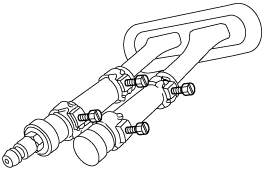 |
HEATER CORE INSPECTION
id071100801600
Heater Core
1. Inspect for evidence of coolant leakage at the heater water hose to heater core attachments. A coolant leak in the heater hose could follow the heater core tube to the heater core and appear as a leak in the heater core.
2. Check the integrity of the heater water hose clamps.
Heater core—Plugged
1. Check to see that the engine coolant is at the correct level.
2. Start the engine and turn on the heater.
3. When the engine coolant reaches operating temperature, feel the heater core outlet hose to see if it is hot.
Heater core—Pressure Test
1. Drain the coolant from the cooling system. (See ENGINE COOLANT REPLACEMENT[AJ (3.0L Duratec)].) (See ENGINE COOLANT REPLACEMENT[L3].)
2. Disconnect the heater hose from the heater core. (See HEATER HOSE REMOVAL/INSTALLATION [AJ (3.0L Duratec)].) (See HEATER HOSE REMOVAL/INSTALLATION [L3].)
3. Install a short pipe of heater hose, approx. 101 mm {4 in} long on each heater core tube.
4. Fill the heater core and heater hose with water and install plug and adapter from the radiator/heater core pressure tester in the heater hose, plug and adapter with hose clamps.
aesffw00000091
|
5. Attach the pump and gauge assembly from the radiator/heater core pressure tester to the adapter.
6. Close the bleed valve at the base of the gauge. Pump 241 kPa {2.46 kgf/cm2, 35 psi} of air pressure into the heater core.
7. Observe the pressure gauge for a minimum of 3 min.
8. If the pressure drops, check the heater hose connections to the core tubes for leaks. If the heater hose do not leak, remove the heater core from the vehicle and carry out the bench test.
Heater core—Bench Test
1. Remove the heater core from the vehicle. (See HEATER CORE REMOVAL/INSTALLATION.)
2. Drain all of the coolant from the heater core.
3. Connect the 101 mm {4 in}test heater hose with plug and adapter to the core tubes. Then connect the radiator/heater core pressure tester to the adapter.
4. Apply 241 kPa {2.46 kgf/cm2, 35 psi} of air pressure to the heater core. Submerge the heater core in water.
5. If a leak is observed, install a new heater core.
aesffw00000092
|